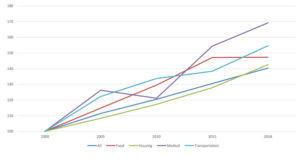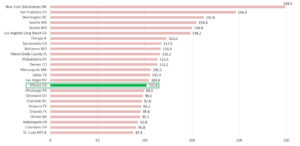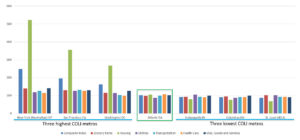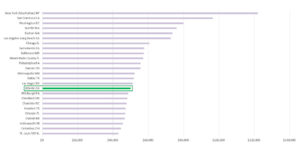Healthcare. Groceries. Housing. If it feels like all of it is getting more expensive, that’s because it is.
The cost of living is increasing steadily in metro areas, including the Atlanta region – but not at the same pace or in the same way.
The data experts at Atlanta Regional Commission took a look at of what these costs look like in metro Atlanta compared to other major metro areas in the nation. Yes, costs are climbing, but the news is not all bad.
And a sourcing note for those curious about what numbers were crunched: Current cost of living comes from the 2018 Annual Cost of Living Index (COLI) from the Council for Community and Economic Research, and data on rising costs is based on the Bureau of Labor Statistics’ Consumer Price Index
With that out of the way, let’s get to the findings.
Though housing costs are rising, healthcare costs are growing even faster
Using the year 2000 as a base, housing costs in metro Atlanta have increased by 43%. But that’s not the only driver of rising living expenses in our region. Costs for medical expenses, food, and transportation have all increased more than housing. The data comes from the Consumer Price Index, which measures change in the cost of consumer items over time. The chart shows the rise in costs using 2000 as the baseline year.

ATL’s cost of living remains near national average
Atlanta’s cost of living is just slightly higher than the national average – about 1.8% higher. Compare that to New York or San Francisco, which are 149% and 96% higher than the national average, respectively. Generally, the most affordable metro areas are in the Midwest and Southeast.
Cost of Living for 25 Largest Metros (index)

Housing is significantly driving up the cost of living in the nation’s most expensive metros
Affordable housing has become a hot topic across the nation, and for good reason. Many parts of the country have seen enormous increases in housing prices, especially on the coasts.
Those huge increases in living expenses in the New York and San Francisco regions are due, in large part, to housing costs that are 523% and 356% higher than the national average, respectively.
The news is a little better for metros in the southeast of the nation. Along with Charlotte, Dallas, Houston, and Nashville/Murfreesboro, Atlanta enjoys housing costs that are on par with the national average, and comparable to its peer metros in the southeast.
Cost of Living Comparison: Highest vs. Lowest Metros

In Atlanta, relatively low living costs mean higher buying power
It’s helpful to understand what cost of living means in terms of income, too. For example, if you earn $50,000 per year in metro Atlanta, you need to take in nearly $80,000 to have a similar lifestyle in Washington, D.C. In San Francisco, that number is more than $96,000, and in New York, it exceeds $120,000. Of our peer cities, it’s Dallas and Charlotte that require the most similar incomes to have the same buying power of an Atlantan who earns $50,000 per year.
Buying Power Compared to $50,000 in Atlanta

What does this mean?
We have more to think about than just housing when we compare our region to pricier metros, particularly those on the coast. As housing costs continue to rise, investments in transportation infrastructure can help soften the sting by making commuting cheaper. Continued emphasis on workforce development can keep wages stable or rising. And quality-of-life investments – those that impact health and wellness – can mitigate growing healthcare costs.
Learn more about the Cost of Living Index at coli.org.
What’s Next ATL, produced by the Atlanta Regional Commission, is a community resource that explores how metro Atlanta is growing and changing, and how the region is addressing its most pressing challenges.


